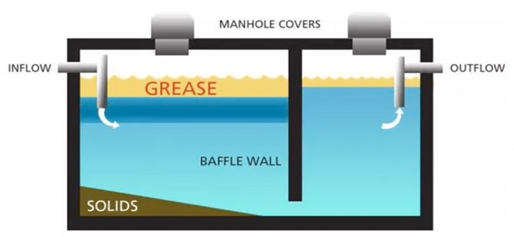3 Key Differences Between a Grease Trap and an Oil-Water Separator
- Brandon Frierson

- Oct 8
- 2 min read
Updated: Oct 14
It is a common misconception that precast grease traps and precast oil water separators are the same thing. While they have a very similar method of treatment/ separation, they both serve their own purpose in protecting the surrounding environment. We will touch on the 3 key differences between a precast grease trap and a precast oil water separator.

Key Difference #1: What is a Grease Trap? What is an Oil Water Separator?
A grease trap is a structure designed to capture incoming FOG (fats, cooking oils, grease) and separate these items from the watery mixture, providing FOG-free water.
An oil-water separator is a structure designed to separate incoming mineral oils and grit from the watery mixture, providing water that is free from mineral oils and grit. The key difference here is what is in the mix entering these structures.
Grease Trap Visual:

Oil Water Separator Visual:

Key Difference #2: Structure Locations
Grease traps are located almost anywhere food service is provided. These structures take on the mixture of water, soap, and FOG that accumulates from floor drains and kitchen sinks. Think of McDonald's, Chili’s, Popeye’s, etc.
Oil water separators are located almost anywhere that mineral oils are present on the ground. These structures take on the mixture of water, soap, mineral oils, and grit that accumulates from floor and bay drains. Consider car washes, mechanic shops, and maintenance areas, among others. The key difference here is that these structures will be located depending on the primary waste product.


Key Difference #3: Final Discharge Location
Once a grease trap has completed its separation process, it discharges into a sewer line. This sewer line then continues, eventually arriving at a type of sewer treatment facility for final treatment before being released into the environment.
Once an oil water separator has completed its separation process, it discharges into a stormwater line. This stormwater line then continues, eventually arriving at a stormwater treatment facility (if required) before entering the environment.


Contact Us
If you would like to learn more about this topic, please schedule a Lunch N Learn with us. You can also contact Cyndi if you have any further questions. While you are here on our website, check out what we do! Thanks for reading!




Comments